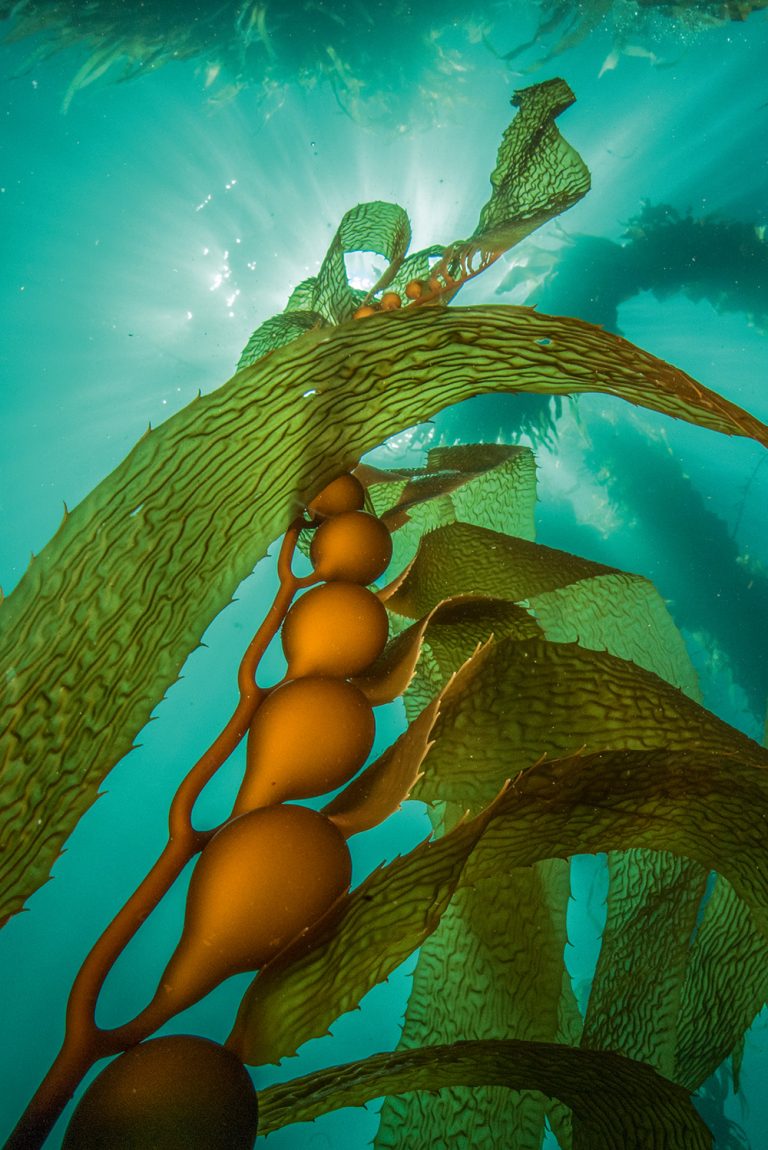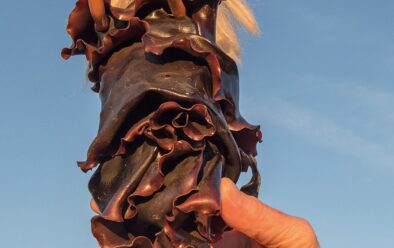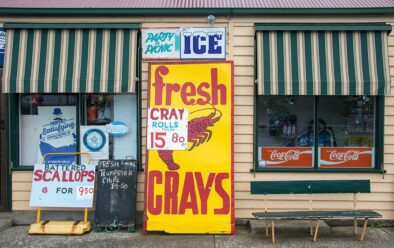KELP DIVER
Australia’s corals grab the headlines, but the country’s kelp-dominated temperate reefs are at least as important and imperilled. Now they’re finally getting the restoration focus they deserve, says STEPHANIE STONE. Photography by JUSTIN GILLIGAN
Also read: Urchin killer sweeps down into Red Sea
The sky is a blameless blue, the air heavy with the pungent smell of salt and fish and something slightly putrid, and the kelp is almost literally everywhere.
It forms thick, slippery blankets over the rocky shore. It hangs from the languid mouths of cows turned loose to graze on the nutritious castaways.
It overflows from trailers pulled by kelpies – locals who collect the washed-up seaweed and sell it to the island’s kelp-processing plant to be turned into feed, fertiliser and food- and beauty-product ingredients.
In town, the brown algae fills the aisles of the Kelp Craft store, where it’s been fashioned into seahorses, weedy seadragons and other decorative wall hangings.
Artist and longtime resident Caroline Kininmonth even uses the frilly fronds to construct designer gowns for Barbie doll installations. Here on King Island, off the north-west coast of Tasmania, bull kelp is so pervasive that it’s hard to imagine a future in which it might not exist.
But the outlook for the region’s kelp forests is anything but clear.
Kelp requires cool, nutrient-rich waters to thrive, so its response to warming seas usually isn’t rosy. Long-term exposure to higher temperatures weakens the seaweed, slows its growth rate, and impedes its ability to reproduce.
When storms assail the compromised kelp, the long algal ropes are frequently ripped loose from the ocean floor. In addition to these direct impacts, ocean-warming allows new herbivores, including tropical fish and urchins, to move into kelp-forest terrain.
In some cases – especially in areas where their natural predators have been fished or hunted too heavily – these invaders can clear-cut large expanses of kelp forest in months.
Last year, a team of scientists led by Dr Thomas Wernberg at the University of Western Australia published a study predicting the response to future climate scenarios for 15 of the most common kelp and other seaweed species across the Great Southern Reef or GSR, a 27,413sq mile band of kelp-dominated Australian coastline that stretches from Brisbane around Tasmania to Kalbarri.
“Even under the most optimistic scenario, these species are predicted to lose 30-100% of their current area to ocean warming by 2100,” ,” says Wernberg.
In Tasmania, where ocean-warming is occurring about four times faster than the global average, the situation is already dire. While several species of kelp have been heavily impacted by warming waters along these coasts, giant kelp (Macrocystis pyrifera) has been hit the hardest.
Over the past 75 years, the species has disappeared from 95% of its former range across eastern Tasmania.
This dramatic decline was first documented by marine ecologist Craig Johnson from the University of Tasmania, who compared aerial photographs taken from the 1940s through 2011 to track the species’ shrinking range.
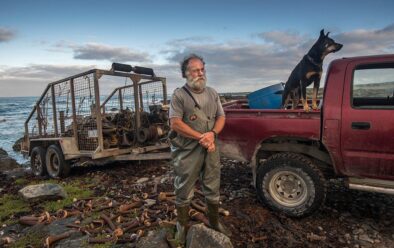
But it’s been discussed for decades by the many residents who make their living along the island’s coastal reefs.
Johnson has heard countless stories from fishermen who say the underwater forests used to be so thick that they had to cut channels through the dense mats to avoid fouling their propellers.
Now, he says, this “iconic and very important coastal marine community is essentially gone from much of the east coast of Tasmania.”
In a bid to protect the country’s few remaining giant kelp stands, the Australian government listed giant kelp forests as an endangered marine community in 2012 – a first-of-its-kind designation that the country’s famously struggling coral reefs have yet to be awarded.
For underwater photographer Justin Gilligan, who grew up just north of Sydney and learned to dive in the kelp-dominated eco-systems of the GSR, giant kelp forests hold a special kind of magic.
“You swim through these swaying forests of giant beanstalks, and because there’s such a large floating canopy on the surface of the water, the understorey is actually quite open,” says Gilligan. “You can explore in 3D and get up into the fronds, and it’s this shadowy, moody, dark world that’s full of unusual creatures.”
Gilligan’s first experience in a giant kelp forest was a little more than a decade ago off the coast of Eaglehawk Neck in southern Tasmania. Back then, he says, there were several healthy giant kelp forests close to town, and commercial dive operator Mick Barron regularly took tourists out to see them.
Today, those forests are all gone. To photograph giant kelp for this story, Gilligan had to travel to the southern tip of Tasmania and board a boat piloted by a commercial abalone diver.
There, in waters too remote to support eco-tourism, he found himself alone and enchanted in some of the last remaining giant kelp forests in Australia.
From a rich forest of towering giant kelp 25 years ago to a stunted crop today, the GSR off eastern Tasmania has undergone a troubling transformation in response to climate change.
The few patches that remain provide critical food, shelter, and breeding grounds for a diverse – and economically important – cast of species.
The GSR, vast as it might be, is the classic hidden treasure. Bringing in more than Aus $7 billion annually in fishing and tourism dollars alone, and within a short drive of some 70% of Australians, one might think its fame would rival that of the Great Barrier Reef.
Yet for most, it remains largely out of sight, out of mind. Until a multi-disciplinary team of scientists, including Craig Johnson, published a paper in 2016 arguing for its recognition, the GSR didn’t even have a name.
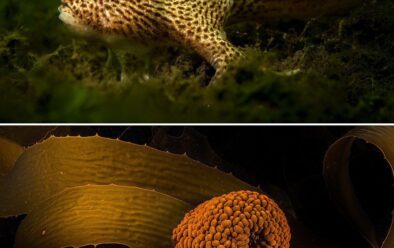
near Hobart. Above: unusually, southern swimming anemones like this one off Maria Island are mobile. They can release their grip and swim, albeit clumsily, to a new patch of kelp in the forest.
The reef’s relative obscurity and under-appreciation are likely due, at least in part, to the understated qualities of the organisms that define it: kelp and other seaweeds.
This is the stuff that fouls propellers and public beaches, that twines around your limbs should you be hardy enough to swim in the frigid waters where it resides.
Unlike their psychedelically hued coral neighbours to the north, most seaweeds – there are thousands of species – are green, and brown, and occasionally a bold, rusty red.
Many of their cohabitants are dressed to match. Still, despite this modest appearance, discounting and undervaluing seaweeds and the complex and important eco-systems they support, would be – has been – a grave mistake.
Kelp and other seaweeds aren’t plants. They’re macro-algae, lumped into the same hodge-podge taxonomic group that encompasses amoebas and slime moulds, but the comparisons are inevitable.
Like plants, they photo-synthesise.
They have leaf-like structures, called blades, that capture sunlight and convert it into storable carbohydrates.
Root-like structures called holdfasts anchor them to the bottom. Stem-like structures, called stipes, carry their blades toward the sun – growing, in the case of giant kelp, at an astonishing rate of 27cm a day.
And like simple plants such as ferns, seaweeds reproduce by releasing spores into their surroundings.
While the physiological resemblance is notable, the functional similarities between seaweeds and plants are far more important.
Like the trees in a rainforest, seaweeds are the foundation of their world, says Adriana Vergés, a marine ecologist at the University of New South Wales.
“They support entire ecological communities,” she explains. “This includes hundreds of species that get shelter, food, and habitat from these seaweeds.”
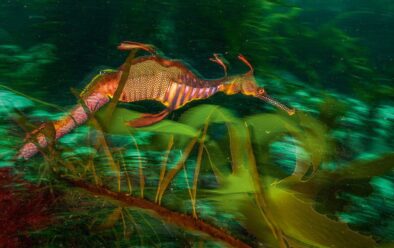
Among the GSR’s many inhabitants are otherworldly animals such as giant cuttlefish and weedy seadragons that draw scuba divers from around the world.
Endangered species such as grey nurse sharks and spotted handfish also call the reef’s underwater forests home.
Not least are economically important species, including rock lobsters and abalone – the invertebrates that support Australia’s two most important fisheries, collectively worth some $357 million annually. To scientists like Vergés and Johnson, who have spent decades studying seaweeds and their decline, the value of these eco-systems is undeniable.
Some of that value is economic, but much of the GSR’s inherent worth lies in the astounding diversity of species it supports.
And much of that diversity is unique. According to the 2016 paper that argued for the reef’s recognition and protection, 30-60% of its species are found nowhere else on Earth.
Geographic isolation – the same factor that gave rise to marsupial mammals – is partly responsible for the GSR’s abundance of unique organisms, the authors wrote.
But so, too, have been the region’s geological and climatic conditions – environmental factors that remained remarkably stable here for 50 million years before the Industrial Revolution.
Their work-day began several hours before sunrise. As thick, ocean-hugging sheets of cold mist crept over the docks in Tasmania’s Pirates Bay, Simon Wally and Shane Bloomfield donned raingear that hadn’t completely dried from the days before, and loaded well-used gear onto the boat.
The sky and water were both still inky when they set off to check the lobster traps they’d dropped the previous afternoon, and the choppy swell seemed designed to urge them back to shore.
But when the sun finally rose, casting a warm glow on the rugged, pristinely forested cliffs that ring the bay, the scene quickly became less forbidding. “It’s a beautiful place to wake up,” says Gilligan.
While Pirates Bay is almost impossibly picturesque above the waterline and below, its depths are increasingly troubled. When Wally and Bloomfield began pulling up their pots, they did find southern rock lobsters huddled inside, though fewer than they used to expect, and smaller.
However, the traps also contained a few eastern rock lobsters, a warmwater species that never used to venture into southern Tasmania. Their haul was a snapshot of a changing fishery.
A 2015 study by University of Tasmania scientists revealed that southern rock lobster larvae experience significantly higher settlement success and lower predation rates when they land in kelp forests rather than in a barren habitat.
It’s no surprise that Tasmania’s native lobsters have become less numerous as kelp forests have disappeared. And while warmer waters have allowed eastern rock lobsters into the region, this species also struggles in degraded habitat.
The rock-lobster fishery isn’t the only industry suffering in the face of ocean-warming. In recent decades, southern Australia’s abalone fishery has been even more heavily impacted by climate change.
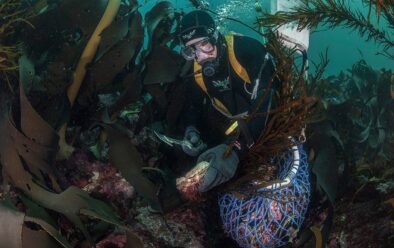
When subjected to warmer-than-usual waters, black-lipped abalone have higher metabolic rates and lower energy stores than normal, which makes them less resilient to stress. An extended oceanic heatwave in 2015 and 2016 claimed many thousands of abalone along the south and south-eastern Tasmanian coast.
Moreover, as kelp forests have declined and kelp-eating urchins have proliferated, abalone have been hit with an additional climate-induced punch. Food is now harder for the shellfish to come by (as kelp is their go-to meal), and there’s suddenly far more competition for limited calories. It’s a competition the abalone rarely win.
Field experiments have demonstrated that when long-spined urchins move into a kelp forest abalone flee, seeking shelter in crevices and crannies where their ability to feed is hampered.
The first long-spined sea urchin was found in Tasmania in 1978. Since then the species, which requires water temperatures of at least 12°C to spawn, has proliferated to an estimated 20 million individuals in Tasmania.
“Ongoing climate change has made the region more and more favourable for long-spined sea urchins,” says University of Tasmania scientist Dr Scott Ling, who led a major survey effort in 2016 and 2017 to track the spread of the invaders.
By the time his study concluded, the urchins had already converted about 15% of Tasmania’s eastern coast to barrens that he calls “underwater deserts devoid of other marine life”. In the absence of any intervention, he predicts that these wastelands will double in size within the next two years, claiming nearly a third of the coastline.
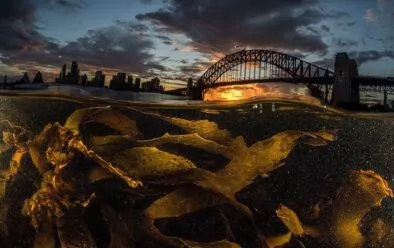
Ling and others are testing and implementing a wide range of urchin-mitigation strategies in a bid to avoid that unsettling outcome. Their efforts run the gamut from lo-tec (engaging abalone and volunteer divers to remove urchins from kelp forests by hand, and developing a fishery for urchin roe) to hi-tec (testing an underwater drone that can autonomously detect and destroy urchins).
Ironically, the most promising tool in their arsenal could be a species that’s struggling alongside black-lipped abalone: the southern rock lobster. In Tasmania, large rock lobsters are the primary predators of long-spined sea urchins and – where their populations are healthy – they can be highly effective kelp-forest guards.
Field studies have shown that even after invasive urchins have arrived in an area, a robust population of rock lobsters can prevent barrens from ever forming.
Scientists are now advocating lower commercial and recreational catch limits for rock lobsters, and they’ve launched a captive rearing program designed to bolster the lobster population in eastern Tasmania.
Collectively, these efforts might give the last remaining giant kelp forests, and the valuable fisheries they support, a fighting chance of survival. But addressing the urchin challenge won’t be sufficient to support this struggling eco-system.
In addition to efforts to protect still-standing kelp-forest remnants, scientists are also working to develop strategies for restoring barren habitat in the face of ongoing climate change. From Sydney to the southern tip of Tasmania, they are beginning to bring kelp and other seaweed species back to degraded habitats.
Four years ago, Craig Johnson and colleagues from the University of Tasmania launched an ambitious effort to transplant healthy common kelp onto more than a hectare of barren seafloor between Maria Island and the eastern Tasmanian mainland, painstakingly anchoring 500 mature individuals onto 28 patches of artificial reef.
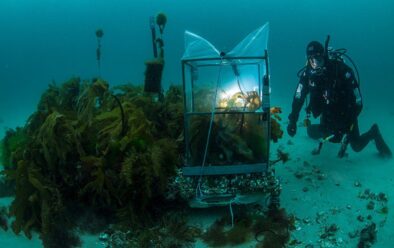
For 18 months they monitored those patches, studying the growth and reproduction success of the kelp and documenting the presence of other organisms drawn to their handmade habitat. Their findings underscore the importance of kelp as an eco-system engineer, and offer important insights for any future, large-scale efforts to restore degraded kelp habitat.
Within six weeks, the team’s transplanted kelp patches were crammed with a wide range of animals and other algae species.
On monitoring dives, the scientists were often treated to remarkable wildlife sightings, such as an interaction between a Maori octopus and an army of spider crabs.
“It was very reminiscent of that movie line: ‘If you build it, they will come’,” says Dr Cayne Layton, a researcher who works with Johnson.
Each transplant patch attracted a diverse cast of species, but the test forests weren’t all equally successful when it came to supporting future generations of kelp.
“One of the primary things we learned is that there is a critical minimum patch size and density that must exist for kelp patches to be self-sustaining,” says Layton. “Juvenile kelp struggle to survive where there is insufficient adult kelp – and we think this is because the adult kelp help to reduce environmental stress, such as high light and sedimentation.”
To be feasible and effective, future kelp-restoration efforts must be self-sustaining. Based on their work with common kelp, scientists now know at least some of what it will take to achieve that goal.
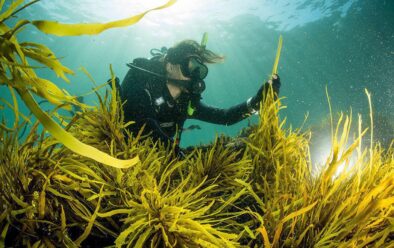
Other localised restoration efforts across the GSR have added to that body of knowledge. Just off Sydney, a team led by Adriana Vergés has transplanted self-sustaining populations of another once-abundant, now-declining seaweed species, an effort she dubbed Operation Crayweed.
The fertile adult crayweeds her team attached to tracts of barren seafloor several years ago are now gone, but their offspring are flourishing, and spreading to colonise new terrain.
Like Layton and Johnson, Vergés learned that minimum restoration-patch sizes were critical to success, partly to help her transplants withstand grazing pressure from herbivores such as urchins. Notably, she also learned how to increase crayweed reproduction rates to levels significantly higher than those on natural reefs.
“We think one of the reasons why our restored crayweed sites have such spectacularly high rates of reproduction is related to the restoration process itself,” says Vergés. “The process of taking the seaweeds out of the water, keeping them dry for 1–2 hours, and then resubmerging them in the ocean is known to stimulate the release of eggs and sperm.”
Most scientists point to past water pollution from Sydney during the city’s rapid growth as the driver of the crayweed decline in that area.
The city has improved water quality, so Vergés is transplanting seaweeds into a relatively healthy environment.
Further south, where the impacts of climate change are already being felt – and are predicted to be particularly severe in the future – scientists like Johnson and Layton don’t have that luxury.
It’s impossible to change those climatic conditions in the short term, says Layton, so they need to focus on transplanting kelp that are tolerant of warmer, nutrient-poor waters.
The University of Tasmania and the Climate Foundation launched a new initiative in November to identify and cultivate giant kelp individuals that are better adapted to a warming ocean.
The team, which includes Johnson and Layton, plan to grow these “super kelp” specimens in 100sq m test plots, manually removing urchins that move in to limit their damage. Within their plots, they’ll look for individuals that can withstand the region’s predicted future conditions.
The fact that 95% of eastern Tasmania’s giant kelp forests are already gone might make their efforts seem futile. But in the other 5%, the scientists see hope.
“Peculiarly, that remaining 5% of individuals, which are scattered right along the coast as single kelp individuals or very occasionally in small patches, appear to be quite healthy,” says Layton.
“And so we are optimistic that we can identify and culture warmwater-tolerant genotypes from these remnant giant kelp and use these as a foundation for effective and wide-scale restoration efforts.”
Reversing climate change is the ultimate solution to much of the degradation these valuable eco-systems are experiencing,
but innovative restoration approaches might at least buy them – and us – valuable time.
